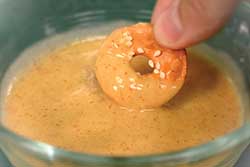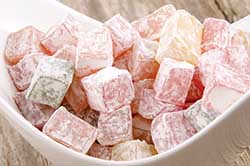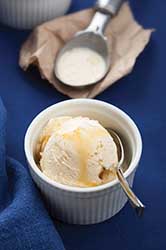Gum System Solutions
INGREDIENTS
 When working with gums, the proof is in the pudding. What that basically means is that there is a wide variety of gums, each with its own specific properties, and it is very important to tailor the right one—or ones—to the application in order to achieve the right functionality without having a negative impact on the finished product. In that respect, gums have always reminded me of sweeteners: Finding the right one in your toolbox is paramount to the success of the application.
When working with gums, the proof is in the pudding. What that basically means is that there is a wide variety of gums, each with its own specific properties, and it is very important to tailor the right one—or ones—to the application in order to achieve the right functionality without having a negative impact on the finished product. In that respect, gums have always reminded me of sweeteners: Finding the right one in your toolbox is paramount to the success of the application.
We’ll talk more about this a little later in the article, but for now the phrase, “proof is in the pudding” takes on a more literal meaning. Recently a Los Angeles-based fortified food and beverage company, Newtritious™, launched a nutritious instant pudding that serves as a weight loss product. The pudding, Kherb Appeal™, provides an excellent source of soluble and insoluble fibers such as glucomannan konjac root, gum acacia, and cellulose. Each has its own individual health benefits, and together have been shown to significantly reduce hunger, positively affect weight loss, and lower triglycerides. The product serves as an example of the growing opportunities that gums have in the area of health, especially weight management and satiety. Satiety has been shown to be a key component in weight loss and weight management, as specific macronutrients affect appetite and ultimately food intake.
Here’s another health opportunity for gums. A published study shows that Sunfiber partially hydrolyzed guar gum from Taiyo can provide relief for youngsters diagnosed with chronic abdominal pain and irritable bowel syndrome. New research published in the January 14, 2013, issue of World Journal of Gastroenterology shows that a widely available soluble fiber, used for years by hospitals to help manage adult IBS symptoms, may also be effective for children at lower doses.
Gums are also being used as an ingredient to help lower levels of sugar and fat, helping to create a better-for-you formula for success.
Besides their potential in the health arena, gums offer a wide variety of functionality properties, which will be addressed in this article. From a functionality perspective, gums can play an increasingly important role in a wide range of opportunities today. As this article will cover, these can include beer stabilization, texturizers for ice cream and bakery products, new confectionery concepts, a sugar alternative in lightly carbonated fruit juice beverages, and many others.
As the need for gums grows, there’s some good news and bad news. First, the bad news. Because of shortages and increased demand for certain gums—both leading to escalating prices—manufacturers are looking for gum alternatives. The good news, however, is that gum suppliers are finding ways to develop new, less expensive gum systems that can meet the challenges previously overcome by more expensive gums that can now be replaced by these systems. It’s interesting, but consider how quickly the world changes for the food formulator. For example, increasingly, sugar is being partially replaced by certain gums which, in turn, are now being replaced by other gum systems. Sounds kind of complicated, but if it gets the job done, that’s what matters.
Let’s now look at the different opportunities that gums can effectively address.
--- PAGE BREAK ---
The Next Generation of Natural Fibers
The next generation of natural fibers, Fibregum Crystal™ is a new, highly purified acacia gum with enhanced properties for performance in clear beverages and functional foods. The ingredient, available from Nexira Inc., Somerville, N.J. (www.nexira.com), provides a broad range of advantages. It offers an excellent source of soluble dietary fiber, is ultra-clear and transparent, is tasteless and odorless, and has lower turbidity than any other source of natural soluble fiber.
According to the company, Fibregum Crystal is an ideal natural solution to replace other dietary fibers that consumers have reported create gas, bloating, and other discomfort. It is an all-natural and GMO-free source of soluble dietary fiber with a guaranteed minimum of 90% on a dry weight basis. Clinical studies have demonstrated the health benefits of the ingredient, and its prebiotic properties at 6, 10, and 15 g/day. The special progressive fermentation of Fibregum by beneficial intestinal microflora improves digestive health with no negative side effects.
Health Canada has recognized the Fibregum brand of acacia gum as a dietary fiber source in Canada. Furthermore, Health Canada has approved the classification of Fibregum as “traditional dietary fiber” and not a “novel fiber.” Health Canada has clearly said that it has no objection to the sale of Fibregum acacia gum as dietary fiber for labeling purposes in Canada. This positive regulatory decision contributes to the growing regulatory acceptance of Fibregum acacia gum worldwide.
After sustainable sourcing from selected species of acacia trees, Fibregum is produced to maintain all the nutritional benefits of natural acacia gum. Also, the minimum 90% soluble fiber in the ingredient is the natural content and has not been highly concentrated from its original plant source. It should be noted that Health Canada specifically stated that any type of modified acacia gum would not be considered as an acceptable dietary fiber source for use in Canada. Health Canada’s policy on the energy value of acacia gum has recently been revised and is now 2 kcal/g vs 4 kcal/g for other carbohydrates. Fibregum acacia gum is currently used in a large variety of food applications in the United States, European Union, and Latin America.
 Nexira—the new identity of Colloides Naturels International and Bio Serae Laboratories—is said to be the world leader in acacia gum and a premier supplier of natural ingredients for the food, nutrition, and health and wellness industries. Among its products is Fibregum, an organic, prebiotic soluble fiber; Equacia™, a soluble and insoluble fiber for fat substitution; and a new natural antioxidant with technical and nutritional benefits.
Nexira—the new identity of Colloides Naturels International and Bio Serae Laboratories—is said to be the world leader in acacia gum and a premier supplier of natural ingredients for the food, nutrition, and health and wellness industries. Among its products is Fibregum, an organic, prebiotic soluble fiber; Equacia™, a soluble and insoluble fiber for fat substitution; and a new natural antioxidant with technical and nutritional benefits.
New Form of Methylcellulose May Enhance Satiety
Traditional methylcellulose is a gum composed of cellulose in which the methoxyl groups replace the hydroxyl groups. It is soluble in cold water but insoluble in hot water. Solutions increase in viscosity upon heating, gel at 50° to 55°C, and liquefy upon cooling. It is used in baked goods for moisture retention, and in fruit pie fillings for the reduction of water absorption into the pie crust during baking. It is also used in breaded shrimp where it functions to form an oil barrier film.
Research presented at the 244th National Meeting & Exposition of the American Chemical Society shows that a new version of methylcellulose—a food additive that has been used for more than 50 years—may offer a satiety effect when added to yogurt, fruit shakes, smoothies, and other foods. A white powder, methylcellulose dissolves in cold water to form a thick solution that turns into a “gel” or gelatin-like material upon heating. It provides a pleasant texture and holds together the ingredients in hundreds of food products such as baked goods, sweet and savory snacks, and ready meals. Carsten Huettermann of Dow Pharma & Food Solutions, previously known as Dow Wolff Cellulosics, noted that this is the first use of methylcellulose as a satiety ingredient in food. Huettermann explained that conventional versions of methylcellulose pass through the stomach rapidly and do not work as a satiety ingredient. This new form of the ingredient—Satisfit-LTG—however, forms a gel at body temperature, and the gel lingers in the stomach before passing into the small intestine.
In the current study, volunteers who consumed Satisfit-LTG experienced a reduction in the sensation of hunger that lasted until the consumption of the following meal in which the volunteers could eat as much as they wanted (2 hr after eating Satisfit-LTG) and a statistically significant reduced intake of calories at this meal. The consumption of Satisfit-LTG resulted in a 13% decrease in caloric intake.
The scientists are developing Satisfit-LTG as a potential ingredient in cold foods, such as smoothies and yogurts, and Huettermann said that work will continue based on the promising clinical trial results.
--- PAGE BREAK ---
 Carrageenan-Containing Beer Stabilizers on Tap
Carrageenan-Containing Beer Stabilizers on Tap
Wort clarifier and beer stabilizer, Polyclar Brewbrite, is an optimized composition of purified food grade carrageenan and specially modified polyvinylpolypyrrolidone (PVPP) that reportedly reduces haze-producing polyphenols in the wort. The highly effective brewing product, developed by Ashland Aqualon Functional Ingredients, Wilmington, Del. (www.ashland.com), can deliver several key benefits.
According to the company, these benefits include upstream wort clarification and beer stabilization with a single addition of the product to the wort; protection against chill haze and permanent haze; improved colloidal stability of beer; improved fermentation characteristics; and increased wort collection. In addition to inhibiting haze formation and loss of clarity, Polyclar products efficiently prevent color deterioration, reduce excessive bitterness, are completely removed by filtration, and protect the flavor integrity of all types of beer.
Furthermore, no specialized equipment (slurry tanks or dosing pumps) are required, and the product is easy to use with no pre-slurrying requirements. Longer filter run lengths are possible, and no labeling is required. Experts are available to deliver technical details on the prevention of chilling and permanent haze in bottled beer through effective and highly selective reduction of polyphenols.
Polyclar Brewbrite is used directly as a powder, or made up as 8–12% slurry in de-aerated water. The brewing product is added to wort during boiling, usually 10 minutes before the end of the boil. It may also be added directly to the whirlpool at the cast stage. The exact amount of wort clarifier and beer stabilizer required would depend upon the brewing raw materials used, process conditions, and the shelf-life requirement.
Different grades within the extensive portfolio of Polyclar stabilizers are available, designed for single use or to be recoverable by filtration. In addition, various grades can be used at different stages of the brewing process.
Using Hydrocolloids to Develop Healthier, Tastier Foods
Scientists at Ashland Specialty Ingredients, Wilmington, Del. (www.ashland.com), a commercial unit of Ashland Inc., are committed to developing new ingredient solutions that satisfy the needs of an ever-changing market. More specifically, Ashland food experts are more focused than ever on developing innovative formulations for reducing fat and sugar while delivering fully indulgent texture and taste.
To bolster this effort, Ashland is expanding its capabilities in a number of ways. First, the newest food applications laboratory opened in Dusseldorf, Germany, in December 2012. Equipped with a vast selection of analytical and process-testing equipment, Ashland scientists can effectively evaluate formulation challenges and select the best chemistries to address customers’ needs.
Further strengthening resources in food laboratories around the world, the global food and beverage team has added nine new scientists and application specialists, each contributing their expertise in hydrocolloid science to areas such as flavors, baked goods, beverages, and confections.
Hydrocolloids play a key role in developing healthier foods with better taste,” said Julie Masker, scientist, at Ashland Nutrition Specialties. “My job is to determine how our multifunctional cellulosics can be specifically tailored to best suit a broad range of applications while delivering the benefits for which customers are looking. Currently, my focus is enhancing the mouthfeel of low- and no-sugar juices to that of a full-calorie beverage.”
--- PAGE BREAK ---
Among the company’s other recent developments are its hydrocolloids for beer brewing and its efforts at developing ingredients that can function as cost-effective alternatives to guar gum. With the cost of guar climbing to new heights amid soaring demand, the company developed two new products. Aquacel™ GSH and Aquasorb™ A-500 are cellulose gums that can be used either to supplement or replace guar, delivering the required flavor and consistency profiles in beverage, bakery, and dairy products.
For ice cream, Aquacel GSH cellulose gum is said to have outstanding viscosity synergy with guar gum to enable formulators to either replace guar altogether or to reduce the overall doses of the total hydrocolloid in their formulations. For bakery products, Aquasorb A-500 cellulose gum reportedly has exceptional waterbinding capacity. Formulators are not only seeing the guar/cellulose gum synergies, but are also improving their products’ yield, moisture, appearance, and shelf life.
To learn more about the company’s latest innovations, capabilities, or scientists, visit the Ashland Innovation Channel on YouTube at www.youtube.com/ashlandinnovation.
75 Years of Carrageenan Production
At the 2013 IFT Food Expo, FMC BioPolymer, Philadelphia, Pa. (www.FMC.com), featured samples of gummy candy and hard candy containing such ingredients as pectin and carrageenan. This year FMC marks its 75th year of producing carrageenan—a gum extract that is obtained from seaweed. Classified mainly as kappa, iota, and lambda types, which differ in solubility and gelling properties, carrageenan may be used to stabilize and to form water gels. Uses include dairy products, water gel desserts, low-calorie jellies, and other products.
As a global leader in seaweed production, FMC recognized compounds found in seaweed including polysaccharides and carotenoids had potential in the global health and nutrition marketplace. This new product portfolio of nature-based nutritional solutions grew from the opportunity to use FMC’s existing raw materials and the company’s experience in harvesting seaweed to provide product performance for customers in the global food, pharmaceutical, and cosmetic industries.
Included in this portfolio is Protasea™ Fucoidan, a brown seaweed extract. This extract provides novel immune health technology available for new product development in select global food supplement markets. The ingredient is described as a gentle, solvent-free, extra virgin fucoidan sourced from Norwegian waters. FMC has pioneered a patent-pending process for obtaining high-purity fucoidan up to 95%.
FMC is one of the world’s leading providers of naturally derived alginate, carrageenan, Avicel® microcrystalline cellulose, pectin, and natural colors. The company serves the worldwide food, pharmaceutical, personal care, and specialty markets.
Earlier this year, FMC acquired pectin-related intellectual property developed by Vigido AG, a subsidiary of UniPektin Ingredients AG and the former exclusive marketer of the pectin products of Pectine Italia, a company whose pectin business FMC acquired in 2012.
The acquisition of Vigido AG’s pectin know-how and customer data strengthens FMC’s pectin portfolio with expertise in marketing and R&D knowledge. Vigido AG products previously marketed under the brand name Vidopectine will now be available from FMC BioPolymer.
--- PAGE BREAK ---
Adding the Vigido expertise to FMC’s newly acquired pectin business provides FMC with benefits that include enhanced ability to service a wide range of low pH food applications; a broader product line with which to provide customized food ingredient solutions; and easier access to many customer applications for the pectin produced in FMC’s Milazzo pectin facility in Italy.
“This acquisition enriches our expertise and capabilities in natural-based food ingredients,” said Mary T. Clarke, General Manager, Food Ingredients for FMC BioPolymer. “For our pectin business, Vigido’s pectin market and application knowledge and formulation experience complements our existing strength in manufacturing and our more than 65 years of experience in the food industry, to solidify our position in the pectin market.”
Staying Focused on Xanthan Gum
“U.S. customers are responding to the consistently high quality and traceability of the xanthan gum products we offer, and the exceptional service we are able to provide because of our singular focus on xanthan gum,” stated Lawrence Herbolsheimer, who was recently appointed CEO of Deosen USA, Piscataway, N.J. (www.deosenusa.com). According to Herbolsheimer, Deosen has reorganized its management structure and added several new sales, marketing, and technical services personnel to support high growth in U.S. xanthan gum sales. In addition, the company has forged technical consulting agreements with professors of food science at Rutgers University, who will assist with product development and technical service.
Deosen produces a complete line of xanthan gums, which are manufactured in the Chinese province of Shandong and Inner Mongolia, and distributed globally.
Deosen’s xanthan gum is a high molecular weight polysaccharide. Produced by fermentation of carbohydrate with Xanthomonas campestris, xanthan gum has a special molecular structure and offers many functionality characteristics in applications. For example, it can be used as a rheology control agent in aqueous systems and as a stabilizer for emulsions and suspensions. Its areas of food application cover a broad spectrum, including salad dressings, coleslaw dressings, hot sauces, pizza sauces, ketchup, sweet relish, mayonnaise, toppings, cake and batter mixes, bakery fillings, fruit preparations, egg white replacers, ice cream, sorbets, yogurts, yogurt milkshakes, creamed cottage cheese, instant drinks, fruit juices, instant soup, squeezable chewing gum, and more.
As formulators become more interested in developing more nutritious, better-for-you products, xanthan gum can find use in applications such as sugar-free instant chocolate drinks, fat-reduced margarine, reduced-calorie salad dressings, light cake mixes, and gluten-free breads.
 New System Boosts Functionality of Pectin
New System Boosts Functionality of Pectin
Although gelatin is a protein, its use in a new system can help boost the functionality of gums such as pectin, especially as it involves confectionery applications.
The Synergy Systems range, developed by Netherlands-based global leader in gelatin and collagen peptides Rousselot (www.rousselot.com), is composed of different types of gelatin or a specific gelatin coupled with another ingredient such as pectin. These combinations work synergistically: the functionality of each gelatin and each additional ingredient is boosted when they are combined.
The latest range from Rousselot allows manufacturers to develop innovative and successful products with new or additional benefits: They can improve texture, taste, stability, or emulsification, or they can be used to develop better-for-you products.
One application that can make use of this new range is Rousselot Delights™, a confectionery treat comparable to a traditional gummy sweet that offers improved heat resistance, allowing it to be stored safely in temperatures between 40–45°C.
--- PAGE BREAK ---
Gums in Lightly Carbonated Juice Drinks
With growing concerns about the sugar content of traditional carbonated soft drinks, manufacturers have responded by introducing sugar-free/ reduced-calorie subcategories. One of these is lightly carbonated beverages containing real fruit juice, creating versions that are more healthy and nutritious than traditional carbonated soft drinks.
By using gums, a carbonated beverage can be formulated that better mimics the ideal represented by full-sugar products without the caloric content. The gum portfolio of CP Kelco, Chicago, Ill. (www.kelco.com), can serve many functions for lightly carbonated juice drinks, including thickening, suspension, stabilization, and manipulating mouthfeel. Gums can also enhance body and mouthfeel in low-calorie versions without impacting the flavor of the beverage, so reducing sugar content is easier.
CP Kelco hydrocolloids can be used as aids to recover body and mouthfeel when formulating no- or reduced-sugar beverages. They can also be used to enhance the mouthfeel of full sugar beverages to suit diverse cultural and regional tastes. When looking to make more affordable products with a lower juice content, CP Kelco hydrocolloids are well positioned to recreate the mouthfeel and sensation of a typical high-juice product at an affordable price. The special ability to provide suspension of pulp, minerals, and nutrients provides the opportunity to formulate novel healthy drinks. To meet the needs of label-conscious consumers, most of the hydrocolloids support a “natural” or “organic” label claim.
Mouthfeel is often described as the “weight,” “body,” or “substance” that a beverage has when being consumed. Recent experimental evidence has shown this mouthfeel can come from two complementary properties of a hydrocolloid. One of those is the increase in density that comes from using a gum such as pectin. Typical use levels of 0.2% or so confer a small but important increase in density that enhances body. A second method to build body in a beverage is to increase viscosity with an efficient thickener such as xanthan gum or cellulose. The use level is even lower in this case, having minimal effect on density. But even a small increase in viscosity can be noticed and contributes to improved mouthfeel. Of course, combinations of gums can be used to tailor the body of the beverage to the customer’s exact requirements.
CP Kelco has a portfolio of many different gum varieties that offer specific properties. Here are some examples: pectin (increased viscosity, refreshing body and mouthfeel, and excellent flavor release); xanthan gum (increased viscosity, body and mouthfeel, clarity, and cold water solubility); gellan gum (long-term suspension of pulp and minerals, minimal viscosity impact, and excellent flavor release); and cellulose gum (viscosity versatility, body and mouthfeel, and cold water solubility).
 Synergistic Gum Blends Debut
Synergistic Gum Blends Debut
At the IFT Food Expo, Gum Technology Corp., Tucson, Ariz. (www.gumtech.com), showcased several new gum systems, which were featured in prototype food and beverage products. Here are some examples.
Coyote Brand® GumPlete™ SSC-FN-612 for vanilla ice cream is a synergistic blend of gum arabic, starch, citrus fiber, and soy fiber that provides improved functionality. The blend imparts a creamy texture, reduces ice crystallization, promotes overrun, helps improve suspension, and slows melting time. Recommended usage level for the blend is 0.87% in the formula.
Coyote Fi™ SA-0520 for lemon lime syrup is a synergistic blend of modified food starch, soy fiber, tara gum, and citrus fiber that provides a number of key benefits. It stabilizes carbonation, preventing loss of effervescence, decreases the size of carbonation bubbles, and stabilizes head foam. Recommended usage level for the blend is 0.15% in the formula.
Coyote Fi TS-0614 for frozen raspberry confections is a synergistic blend of tara gum and soy fiber. In this application, it creates a smooth and creamy texture, protects proteins in a high-acid environment, and reduces ice crystal size. Recommended usage level for the blend is 0.25% in the formula.
Coyote Brand Gumplete SCS-CN-506 for vegan marshmallow synergistically blends carrageenan, modified food starch, and soy fiber. It provides structure in a gelatin-free marshmallow, promotes aeration and stabilizes the air cells, improves consistency, and is vegan and kosher. Recommended usage level for the blend is 2.72% in the formula.
Coyote Brand Gumplete SXCT-GF-707 for gluten-free brownies is a complete stabilizing system that synergistically combines xanthan gum, tara gum, tapioca flour, rice flour, and citrus fiber. The synergistic blend mimics the texture of a full-gluten brownie, reduces dryness and raininess, and provides structure. Recommended usage level for the stabilizing system is 15.3% in the formula.
Coyote Brand Gumplete SAC-DM-204 for vanilla mousse is a complete stabilizing system synergistically combining gum arabic, carrageenan, xanthan gum, tara gum, and native corn starch. In this application, it improves aeration and emulsion and provides structure for whipped dessert. Recommended usage level for the stabilizing system is 3.45% in the formula.
Coyote Brand GumPlete ST-FF-402 for bake-stable filling is a synergistic blend of tara gum and tapioca starch. The complete stabilizing system promotes bake stability, prevents filling from seeping into crust, imparts a clean flavor release, and consists of natural ingredients. Recommended usage level is 2.5% in the formula.
--- PAGE BREAK ---
Several recent developments influenced the creation of these blends. One of these is the comprehensive Coyote Brand GumPlete systems, which are carefully formulated blends of gums and starches that provide benefits above and beyond a single gum or a single starch. Starches and gums are widely used in the industry; however, incorporating these hydrocolloids together or independently in an efficient manner can be complex. There are many variables to take into consideration to ensure that both the gums and the starches achieve their full functionality. Coyote Brand GumPlete systems are designed to ensure that starch and gums work synergistically rather than compete with one another.
The GumPlete systems can help to reduce costs since they can be used at lower usage levels than starches alone. In addition, the resulting lower usage level of starches minimizes their flavor-masking effects, which then allows for a reduction of the amount of flavorings needed, resulting in further savings. Functional and efficient, the systems help to provide a cleaner flavor release. The systems also help to minimize syneresis, particularly in freeze/thaw and microwave applications. The systems stabilize viscosity over a wide temperature range. The precise combinations of gums and starches in the systems can help control critical temperature points, thereby reducing or increasing set and gelation temperatures.
The systems also improve the texture and mouthfeel of products containing starch. For example, gums can reduce graininess in yogurt and provide a creamier texture. They also help to stabilize emulsions; for example, in sauces, where the only thickening agent is a starch, the addition of gums can stabilize the emulsion while allowing for the reduction of the total amount of thickener used.
Gum Technology and Fiberstar have recently formed a collaboration to create Hydro-Fi™, an all new line of texturizing ingredients. These ingredients combine Coyote Brand hydrocolloids with Fiberstar’s Citri-Fi citrus fiber, providing innovative solutions for specific challenges in food formulating. For example, in reduced-fat ice cream and sorbet, Hydro-Fi reduces ice crystallization, improves texture, increases overrun, and delays melting.
Gum Technology has expanded its portfolio range to include Coyote Brand Soy Fiber. Combining the soy fiber with highly compatible gums and starches provides improved functionality. Derived from soybeans by aqueous extraction and refined, sterilized, and spray-dried, the ingredient is composed of soluble polysaccharides. Rich in soluble dietary fiber, it disperses in both hot and cold water without forming a gel. High concentration aqueous solutions (30% or more) can be prepared using this product.
Gum Technology also has a new, superior grade of tara gum available. Coyote Brand tara gum is said to be more dispersible than other tara gums and has a lower bacterial load compared to others. It is also more consistent from batch to batch due to innovative continuous processing methods. Tara gum is a natural hydrocolloid obtained by a mechanical process from the endosperm of tara tree seeds. Tara gum is often used as a replacement for locust bean gum and is widely used in dairy applications, baked goods, beverages, fruit fillings, and frozen products.
Tara gum and tara gum blends are often an excellent alternative to guar gum since tara gum comes from the same family of galactomannans. Once the lowest priced, most widely used gum, guar has now become one of the most expensive hydrocolloids. Coyote Brand tara gum is abundant, and there is a sustainable supply. Tara gum, in particular, is very effective in baking and combines synergistically with other gums such as carrageenan and xanthan gum. In frozen desserts such as ice cream, tara gum alone offers a creamier, silkier texture vs the texture of guar alone.
Cookies and Milk … and Gums
A twist on a milk and cookies concept developed for the 2013 IFT Food Expo by Univar Food Ingredients, Redmond, Wash. (www.univar.com), in partnership with CP Kelco, uses a variety of hydrocolloids. In that concept—Sweet Cinnsation cookies served with almond milk—both the milk and the cookies feature reduced sugar and sodium. The almond milk is formulated with various hydrocolloids that provide a smooth and creamy texture while uniformly suspending calcium to deliver as much calcium as traditional dairy milk. The cookie is fortified with fiber and contains all natural antioxidants. Also available is a decadent gluten-free cookie that demonstrates the performance of xanthan gum.
Need to find the right gum? During the Food Expo, Univar unveiled its new interactive formulation tool for selecting ingredients, including hydrocolloid stabilizers for texture enhancement. The tool enables customers to search for the appropriate ingredient for their formulation, and provides resources on health and wellness, product enhancement, and process improvement. The searchable tool features dozens of ingredients from well-known suppliers, making it a one-stop shop for finding new ingredients. It allows food developers and manufacturers to compare attributes of dozens of ingredient options in one quick search.
--- PAGE BREAK ---
Systems Serve Up Texture, Stability, and More
At the Food Expo, TIC Gums, White Marsh, Md. (www.ticgums.com), showcased two hydrocolloid technologies, Saladizer Max® and Add-Here® CSA.
Saladizer Max is a patented technology designed to provide emulsion and texture solutions for full-fat, reduced-fat, and fat-free dressings, sauces, and dips. This hydrocolloid system provides increased mouth coating and slipperiness, which mimics the creamy mouthfeel that consumers expect while also eliminating separation during the producing, shipping, and purchasing process.
According to the company, there are textural challenges beyond viscosity when reducing fat in dressings, sauces, and dips. Without impacting viscosity, Saladizer Max significantly highlights the other textural attributes associated with fat. The technology features the company’s Prehydrated® agglomeration process to create a hydrocolloid system that easily disperses and rapidly hydrates. It can be used alone or in combination with Saladizer FB-50, when additional viscosity and body is needed.
Saladizer FB-50 is also a new technology that has been optimized to balance stabilizer and texture requirements for dressings, sauces, and dips. It is a way to build viscosity without adding textural defects associated with a single ingredient solution. The cold water soluble hydrocolloid system provides stabilization requirements for dressings, sauces, and dips, such as viscosity, suspension, and emulsion stabilization.
The Saladizer series demonstrated its texture and stability properties in a spicy honey mustard dip prepared by TIC Gums’ food scientists at the 2013 Food Expo. It showed in particular how such a gum system can address key food manufacturers’ needs. Representatives were on hand to describe the patented technology developed to emulsify and improve texture in full-fat, reduced-fat, and fat-free dressings, sauces, and dips. Attendees were also able to learn about the emergence of texture as a key market differentiator in salad dressings, sauces, and dips.
Add-Here CSA is an advanced hydrocolloid system designed to assist the snack and bakery industry with its particulate adhesive needs. For example, the system can function as a binder and film former that will stick inclusions such as sesame seeds or poppy seeds to baked goods. By creating a strong binding film on food products, the system, which stands up well to the rigors of a product’s life cycle, allows food developers to gain up to 40% more particulates on finished products. This is a valuable attribute because increasingly bakery product developers are looking to added toppings to help differentiate their products in the marketplace while streamlining costs. It is also a healthful solution because it replaces oil spray.
A blend of gums developed specifically for baked goods and snack foods, Add-Here CSA is cold water dispersible, dissolves quickly, and can be sprayed easily. With its sticky and film-forming characteristics, the system can hold more inclusions than water or eggs and does not have the allergy issues associated with eggs. Applications for the system include sticking inclusions to bagels, crackers, chips, cookies, biscuits, and crisps.
Previously, TIC Gums developed TicaPan® Quick Crunch, which can match or exceed the performance of gum arabic in panned confections such as candy and chewing gum, with up to 10% fewer shell layers needed without sacrificing quality or performance while saving money and time. With the gum system, candy and gum makers need fewer “coats” or layers of panning agent to get the same outcome on the shells of gum and candy. It also dries 20% faster than gum arabic, is stronger, and is whiter in color. Gum arabic is not white, but more of a beige color that has to be changed. The whiteness of the gum system eliminates the need for dyes or other processes that add steps and expense. Faster drying time means as much as a 20% increase in productivity without the addition of more personnel or equipment.
The coating system was developed to provide a solution for the sometimes unstable gum arabic market. While useful, gum arabic is one of the most difficult gums to source. Its availability is often subject to situations including political instability, draught, floods, or other natural or manmade disasters. In addition to strengthening the sugar and sugar alcohol shells in panned confections, the TicaPan coating system also works well for covering/enrobing nuts, malt balls, chocolate candy, and other edible products with centers that contain volatile oils.
--- PAGE BREAK ---
Say Cheese
A new range of stabilizers from Spain-based Premium Ingredients (premiumingredients.es) is based on modified starch and hydrocolloids specifically designed to reduce formulation costs in the individually wrapped cheese slice manufacturing process. The Premitex® line of stabilizers is able to reduce the formulation cost by gradually reducing the protein content and dry matter while keeping optimal functionality both during the manufacturing process and in the cheese application. This range of products presents an excellent separability of the plastic foil, allowing an optimal manipulation of cheese slices. They also melt and add creaminess to any kind of sandwiches.
Premitex XLK-13023 has been designed for the production of very low cost individually wrapped cheese slices with 4% protein content. XLK-13024 is a suitable solution for low cost individually wrapped cheese slices with a 7% protein content. XLK-13025 allows the production of individually wrapped slices for traditional melted cheese with 11% protein content. The whole range of stabilizers may be used on any melting equipment on the market.
Where Gums Are Going
As this article has shown, there are several factors influencing gum usage, and these factors will likely provide stronger incentives with the passing of time. The first reason is a traditional one: Gums are very versatile and can offer a range of functionalities from adhering seeds to a bagel to beer brewing to developing reduced-sugar lightly carbonated juice drinks. A whole book could easily be written around their uses by food and beverage manufacturers, and because of the special properties they offer, these uses will likely continue to expand.
Second, while gums have been known primarily for their functionality, they can also play a role in the health arena. Weight management, satiety, fiber, glycemic index, and sugar replacements can all help fuel their usage in food and beverage formulations.
Third, as formulators continue to explore the attributes that texture provides, gums, of course, with their special functionality properties, play a significant role that goes beyond merely viscosity.
And finally, with gum shortages and rising demand for certain gums, it becomes more important that new gum systems are discovered that can take the place of certain gums. And as we have seen, in some cases, gum suppliers have argued that their new gum systems are actually superior to the gums they are replacing.
Take all these factors together, and the potential for gum usage is clearly growing.
Next month’s Ingredients section will zero in on what’s cooking in the world of ingredients for soup formulations.
Know Your Gums—From A to X
Gums are polysaccharides that function as water-control agents by increasing viscosity (resistance to flow) or by forming gels. Gums are classified by source according to principal groupings. Here are some examples (alphabetically) of gums along with their particular grouping.
• Agar (seaweed extract)
• Alginates (seaweed extract)
• Arabic (plant exudate)
• Arabinogalactan (plant extract)
• Carboxymethyl cellulose (cellulose derivatives)
• Carrageenan (seaweed extract)
• Dextran (fermentation gum)
• Furcellaran (seaweed extract)
• Gellan (fermentation gum)
• Ghatti (plant exudate)
• Guar (plant seed gums)
• Hydroxypropylmethyl cellulose (cellulose derivative)
• Karaya (plant exudate)
• Locust bean (plant seed gums)
• Low-methoxl pectin (gum derivative)
• Microcrystalline cellulose (cellulose derivative)
• Pectin (plant extract)
• Propylene glycol alginate (gum derivative)
• Psyllium (plant seed gums)
• Quince (plant seed gums)
• Tamarind (plant seed gums)
• Tragacanth (plant exudate)
• Xanthan gum (fermentation gum)
www.ift.org
Members Only: Read more about gums and gum systems online at www.ift.org. Type the keywords into our search box at the upper right side of our home page.
 Donald E. Pszczola,
Donald E. Pszczola,
Senior Editor
[email protected]


